South Dakota is located in the Midwestern United States and consists mostly of rolling hills and grasslands. Thanks to its rivers and glacial lakes, it also boasts more coastline than Florida. This state, known for the Black Hills, mammoths, Mount Rushmore, and the Crazy Horse Memorial, also has a variety of beautiful wildlife. We rounded up the biggest animals the Mount Rushmore State hosts and gathered a little information about each creature. Read on to discover the six largest animals in South Dakota.

1. Largest Mammal in South Dakota: American Bison (Bison bison)
Except for the coasts, Bison once roamed most of North America, and they are the longest and heaviest mammal on the continent. This is true in South Dakota, even though the moose also lives in this rugged state.
While the moose is a taller animal, the bison has it beat in both weight and length. Scientists recognize two subspecies of bison, the plains bison (B. b. bison) and wood bison (B. b. athabascae). Of the two, the wood bison is the larger; bulls exceed 2,000 pounds in weight. However, the plains bison is far more common and the one you’re most likely to encounter in the South Dakota Badlands. Plains bison stand up to 6.5 feet tall at the withers and weigh up to 2,000 pounds. Their head-to-tail length can reach 11 feet.
American bison are shaggy giants, fiercely protective of their young, and extremely aggressive during rutting season. They’re huge and majestic but not gentle. There are a few incidents yearly where people are attacked by bison when they’ve gotten too close to them.
These bovine behemoths were once nearly extinct until a few groups around the country saved enough of them to rebuild the populations. Now, there are an estimated 31,000 wild bison roaming North America, and even more are raised as livestock for meat.
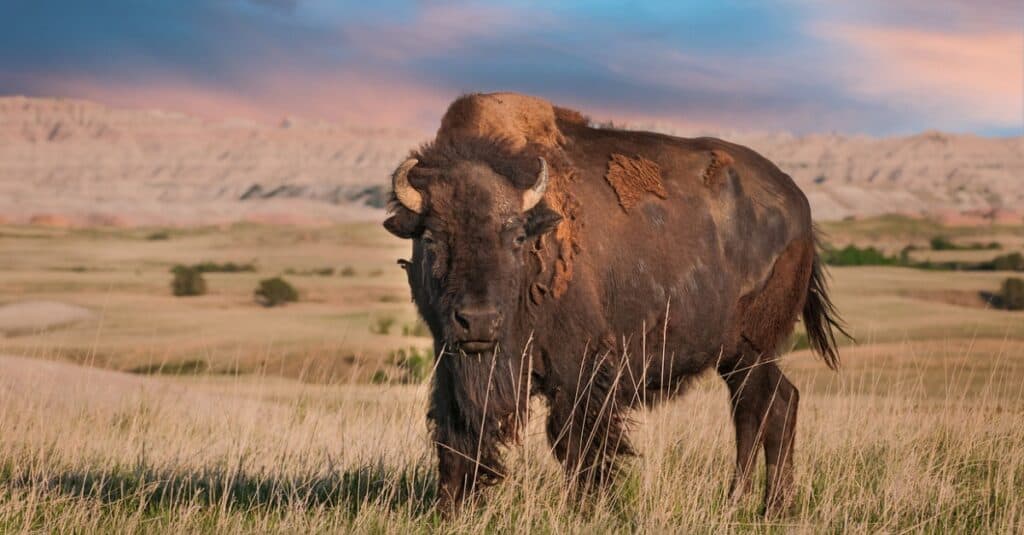
American bison are shaggy giants, fiercely protective of their young, and extremely aggressive during rutting season.
©Geoffrey Kuchera/Shutterstock.com
2. Largest Bird in South Dakota: American White Pelican (Pelecanus erythrorhynchos)
The next species on our list is also the second-largest bird in North America. American white pelicans typically spend time in the coastal areas in Florida, the Gulf Coast, and California during the winter. They have a range that encompasses most of North America, at least during migrations. However, they do have a few resident populations in regions scattered about the continent — two of those are in South Dakota, in the southwest, and in the northeast of the state.
The American white pelican boasts a 9.5-foot wingspan. As big as they typically grow, there are a few reports of individuals with wingspans approaching 12 feet. This giant bird is all white with black flight feathers and an orange-pink bill and pouch. Young individuals have brown bills and crowns, and their feathers are more off-white, giving them a dirtier appearance.
According to the IUCN Redlist of Threatened Species, these birds are not threatened and, thanks to their wide distribution, appear to have a stable population. These pescatarians catch their favorite food by skimming the water’s surface, then straining the water to keep the fish.
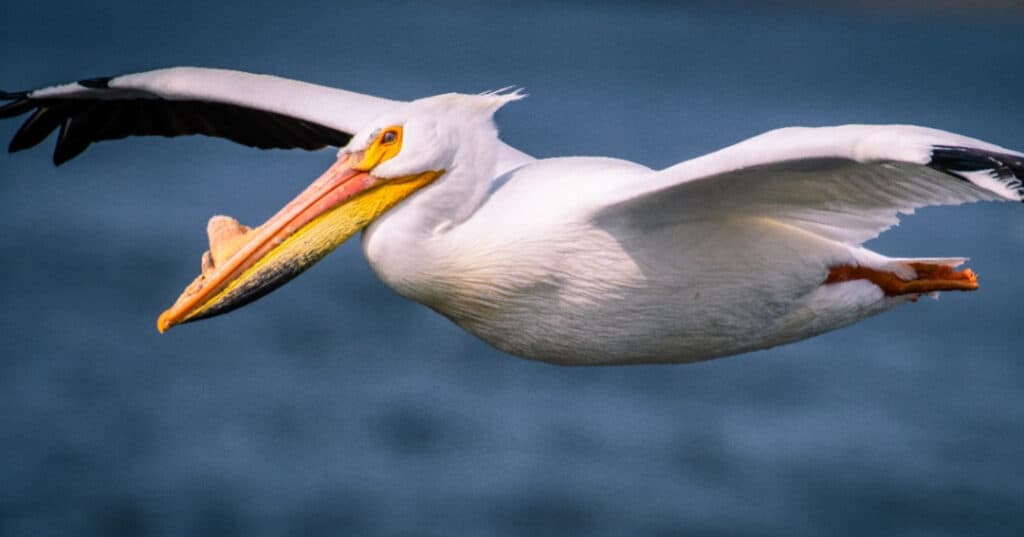
The American white pelican boasts a 9.5-foot wingspan.
©Jerek Vaughn/Shutterstock.com
3. Largest Snake in South Dakota: Bull Snake (Pituophis catenifer)
This nonvenomous colubrid snake’s extensive range means that many people will run across one or several in their lifetimes. Bull snakes have one of the most extensive ranges of any snake in North America, with the possible exception of garter snakes. They inhabit areas from southern Saskatchewan and Alberta, Canada, all the way to Mexico. They’re common in the Great Plains and Midwestern United States, including South Dakota, Wisconsin, and Colorado.
Bull snakes average between 4 and 6 feet long with a maximum recorded length of 8 feet 4 inches. They may be the biggest of all the gopher snakes and can be stocky for a colubrid, sometimes weighing nearly 10 pounds.
They’re listed as a species of least concern owing to their wide distribution and stable population. Bull snakes eat various rodents such as mice, rats, moles, ground squirrels, and pocket gophers. They’ll also eat ground-nesting birds, eggs, and lizards. This species is highly adaptable and an excellent climber, which allows them to raid bird nests.
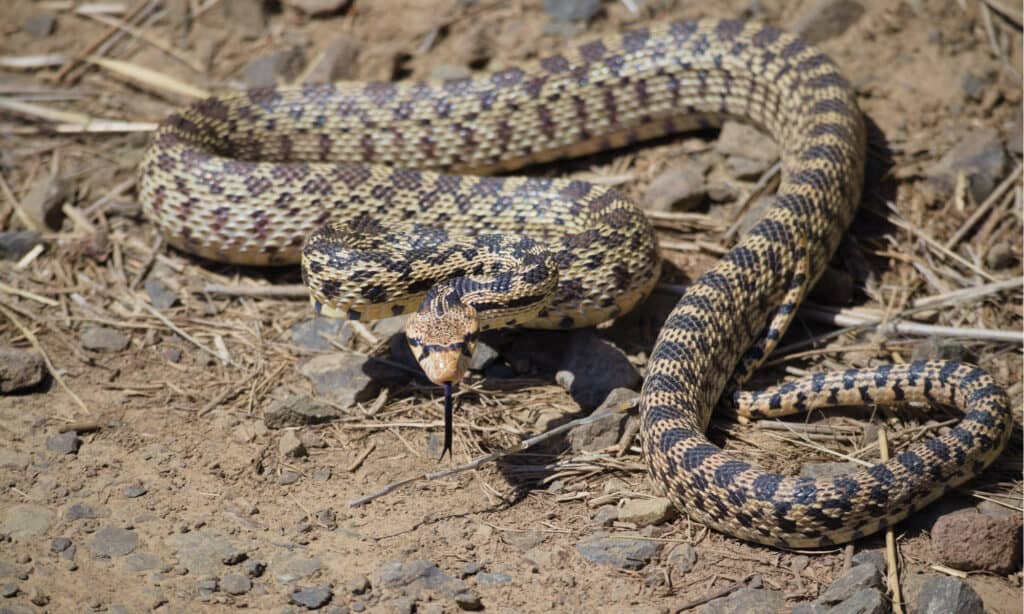
Bull snakes average between 4 and 6 feet long and can weigh up to 10 pounds.
©Christopher Joe Brown/Shutterstock.com
4. Largest Amphibian in South Dakota: Barred Tiger Salamander (Ambystoma mavortium)
Amphibians are sort of an odd class of animals; they start life as water-breathing tadpoles, then sprout legs and lungs, and leave the water. Some, like frogs and toads, shed their tales, but others, like salamanders, keep their tail. Barred tiger salamanders are one of the biggest salamander species in North America, with a wide range that includes South Dakota, the western United States, and western Canada.
Barred tiger salamanders average 6 to 8.5 inches long but can reach 12 inches from nose to tail. They have two distinct morphs in the wild: the typical and the cannibalistic. Cannibals change from larvae to adults earlier and live in drier areas with more competition. The cannibalistic form has large teeth with wider heads and slender bodies. They use their teeth to hold their prey which includes fathead minnows.
This species eats almost anything it can fit into its mouth. Earthworms, spiders, snails, slugs, and other insects are all on their menu. Barred tiger salamanders are one of the most widespread salamander species in North America and popular pets because of their non-aggressive nature.

Barred tiger salamanders average 6 to 8.5 inches long but can reach 12 inches from nose to tail.
©Creeping Things/Shutterstock.com
5. Largest Insect in South Dakota: Giant Swallowtail Butterfly (Papilio cresphontes)
This insect’s striking black and yellow stripes make it stand out wherever it lives. Giant swallowtail butterflies are common, and South Dakota seems to have an unusually wide variety of swallowtail species. This species is common throughout the eastern United States and is easily identified by its vivid markings.
Giant swallowtail butterflies are the largest butterfly in North America, but the Tiger swallowtail comes close. These butterflies sport black or dark brown wings with bright yellow markings, while the underside is mostly yellow. Their wingspan can measure over 8 inches, but most average 4 to 6 inches.
Like most butterflies, giant swallowtails sip nectar from their favorite flowers while their larvae eat the leaves of plants. These butterflies are a common sight in South Dakota during the spring, but their lifespan is sadly short, and the adults only live for a couple of weeks.
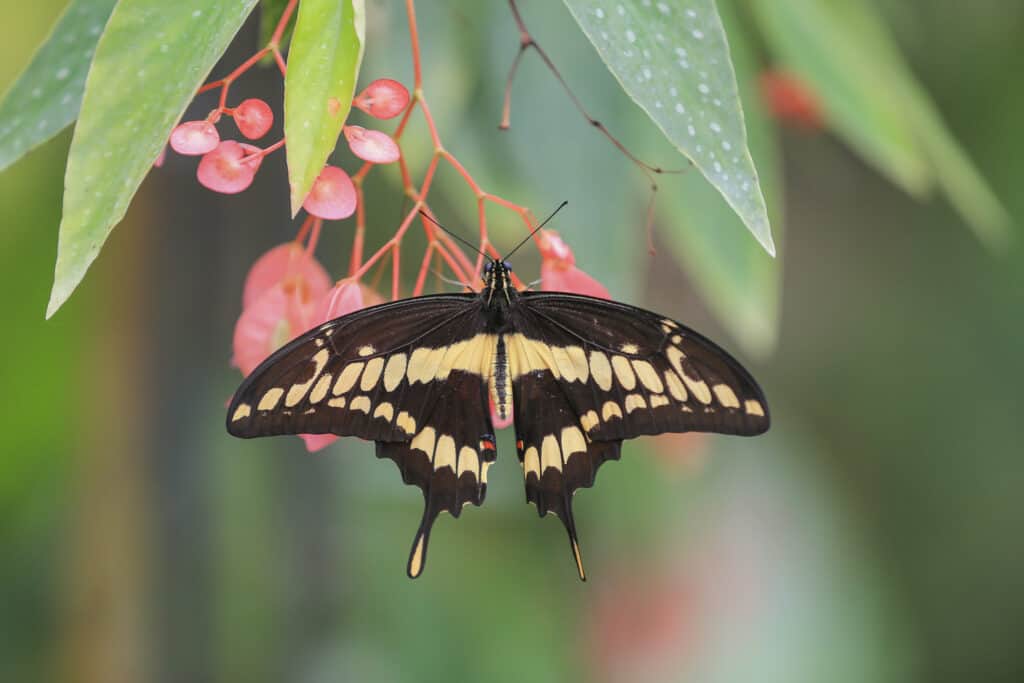
Giant swallowtail butterflies are the largest butterfly in North America.
©iStock.com/rybalov77
6. Biggest Fish in South Dakota: Pallid Sturgeon (Scaphirhynchus albus)
In terms of big, these fish beat most of the others in North America. The pallid sturgeon is a North American native and inhabits most of the Missouri River and parts of the Mississippi. This prehistoric species is considered a living fossil. Like its cousin, the paddlefish, the pallid sturgeon prefers open, fast-moving waters.
Pallid sturgeon grow to astounding lengths, often exceeding 7 feet. They lack the scales and bones that more modern species exhibit and instead have shark-like cartilaginous skeletons. These fish have a long lifespan and may live up to 100 years. Pallid sturgeon also mature slower than smaller, shorter-lived species. Males probably reach sexual maturity between five and seven years; however, the females mature much later, somewhere after their 15th year.
Dam building along the Mississippi and Missouri Rivers has prevented pallid sturgeon from migrating upriver to spawn, and fishing pressures have also taken their toll on the population. This species is endangered, and many fisheries breed and release juveniles into the Missouri and Mississippi Rivers to help the pallid sturgeon population recover. Other recovery efforts include restoring some of their natural habitats, such as the Missouri National Recreational River area on the border between Nebraska and South Dakota.
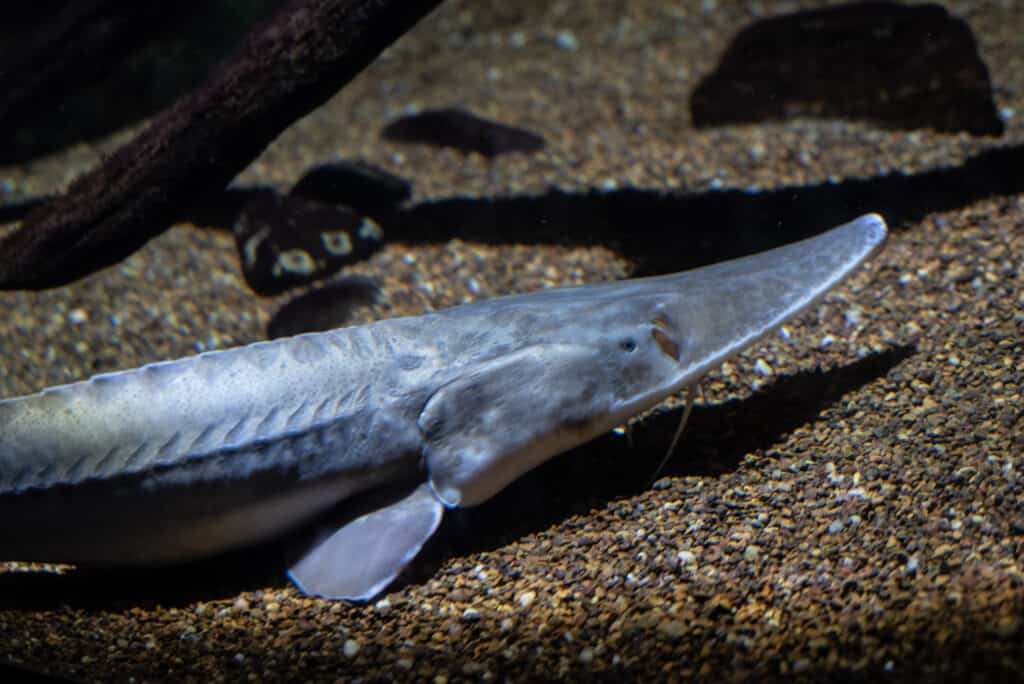
Pallid sturgeon have a shark-like cartilaginous skeleton and often exceed 7 feet in length.
©iStock.com/rmbarricarte
Summary of the 6 Largest Animals in South Dakota, and Where You’ll Find Them
Here’s a recap of the six biggest animals found in South Dakota that we took a look at.
| Number | Animal | Scientific Name | Category | Size |
|---|---|---|---|---|
| 1 | American Bison | Bison bison | Largest Mammal | Plains bison stand up to 6.5 feet tall and weigh up to 2,000 pounds. Wood bison bulls exceed 2,000 pounds in weight. |
| 2 | American White Pelican | Pelecanus erythrorhynchos | Largest Bird | 9.5-foot wingspan; some are up to 12 feet |
| 3 | Bull Snake | Pituophis catenifer | Largest Snake | 4-6 feet long; can weigh up to 10 pounds |
| 4 | Barred Tiger Salamander | Ambystoma mavortium | Largest Amphibian | On average 6-8.5 inches long; can reach 12 inches from nose to tail |
| 5 | Giant Swallowtail Butterfly | Papilio cresphontes | Largest Insect | Wingspan average is 4-6 inches; can be over 8 inches |
| 6 | Pallid Sturgeon | Scaphirhynchus albus | Largest Fish | Often exceed 7 feet long |
The photo featured at the top of this post is © O.S. Fisher/Shutterstock.com
Sources
- BirdLife International. 2016. Pelecanus erythrorhynchos. The IUCN Red List of Threatened Species 2016: e.T22697611A93624242. https://dx.doi.org/10.2305/IUCN.UK.2016-3.RLTS.T22697611A93624242.en. , Available here: https://www.iucnredlist.org/species/22697611/93624242
- Largest Birds in North America | Birding Digest, Available here: https://birdingdigest.com/largest-birds-in-north-america/
- Bull Snake | Reptarium Reptile Database, Available here: https://reptile-database.reptarium.cz/species?genus=Pituophis&species=catenifer&search_param=%28%28genus%3D%27pituophis%27%29%29
- IUCN SSC Amphibian Specialist Group. 2022. Ambystoma mavortium. The IUCN Red List of Threatened Species 2022: e.T199970A196342549. https://dx.doi.org/10.2305/IUCN.UK.2022-1.RLTS.T199970A196342549.en., Available here: https://www.iucnredlist.org/species/199970/196342549
- Giant Swallowtail Butterfly | Butterflies at Home, Available here: https://www.butterfliesathome.com/giant-swallowtail-butterfly.htm
Thank you for reading! Have some feedback for us? Contact the AZ Animals editorial team.






